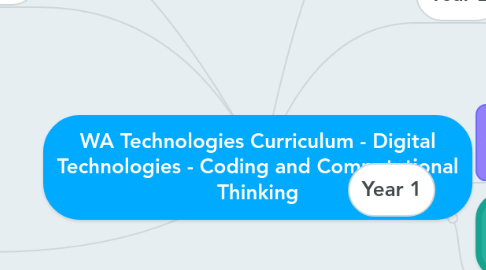
1. Year 6
1.1. Students further develop understanding and skills in computational thinking such as identifying similarities in different problems and describing smaller components of complex systems. They will have opportunities to create a range of solutions, such as quizzes and interactive stories and animations that involves more than one branching solution (choice of options).
1.1.1. Design, modify, follow and represent both diagrammatically, and in written text, simple algorithms (sequence of steps) involving branching (decisions) and iteration (repetition) (ACTDIP019)
1.1.2. Define a problem, and a set of sequenced steps, with users making decisions to create a solution for a given task
1.1.3. Design, modify, follow and represent both diagrammatically, and in written text, alternative solutions using a range of techniques, appropriate technical terms and technology
1.2. Students consolidate their understanding of the role individual components of digital systems play in the processing and representation of data. Students learn to further develop abstractions by identifying common elements across similar problems and systems and make connections between models and the real-world systems they represent.
1.2.1. Collect, sort, interpret and visually present different types of data using software to manipulate data for a range of purposes (ACTDIP016)
1.2.2. Digital systems have components with basic functions and interactions that may be connected together to form networks which transmit different types of data (ACTDIK014)
1.2.3. Implement and use simple visual programming environments that include branching (decisions), iteration (repetition) and user input (ACTDIP020)
2. Year 5
2.1. Students further develop understanding and skills in computational thinking, such as identifying similarities in different problems and describing smaller components of complex systems. They have opportunities to create a range of solutions, such as games and interactive stories and animations that involve branching (choice of options). When creating solutions, students identify appropriate data and requirements. They develop skills to write clear algorithms by identifying repetition and incorporate repeat instructions or structures when implementing their solutions.
2.1.1. Design, follow and represent diagrammatically, a simple sequence of steps (algorithm), involving branching (decisions) and iteration (repetition) (ACTDIP019)
2.1.2. Define a problem, and set of sequenced steps, with users making a decision to create a solution for a given task
2.2. Students explore the role that individual components of digital systems play in the processing and representation of data.Students use abstractions by identifying common elements across similar problems and systems. They develop an understanding of the relationship between models and the real-world systems they represent.
2.2.1. Data is represented using codes (ACTDIK015)
2.2.2. Collect, store and present different types of data for a specific purpose using software (ACTDIP016)
2.2.3. Implement and use simple programming environments that include branching (decisions) and iteration (repetition) (ACTDIP020)
3. Year 3
3.1. Students further develop understanding and skills in computational thinking, such as categorising and outlining procedures. They have opportunities to create solutions, such as interactive adventures and simple guessing games that may involve user choice.
3.1.1. Create a sequence of steps to solve a given task
3.2. They collect and present data, developing an understanding of the characteristics of data and their representation.
3.2.1. Collect and present different types of data using simple software to create useful information (ACTDIP009)
3.2.2. Use visually represented sequenced steps (algorithms), including steps with decisions made by the user (branching) (ACTDIP011)
3.2.3. Select, and safely use, appropriate components with given equipment to make a solution
4. Year 4
4.1. Students further develop understanding and skills in computational thinking, such as categorising and outlining procedures. They have opportunities to create a range of solutions, such as interactive adventures that involve user choice, modelling simplified real world systems.
4.1.1. Define a sequence of steps to design a solution for a given task
4.1.2. Develop and communicate design ideas
4.2. They collect, manipulate and interpret data, developing a capacity to use data and their representations to communicate ideas. They have opportunities to experiment with refining designing skills, describing their own algorithms that support branching (choice of options) and user input. Students implement solutions using appropriate software,
4.2.1. Collect and present different types of data for a specific purpose using software (ACTDIP009)
4.2.2. Data can be represented in different ways (ACTDIK008)
4.2.3. Use simple visual programming environments that include a sequence of steps (algorithm) involving decisions made by the user (branching) (ACTDIP011)
5. Year 2
5.1. Broadening students prior skills in computational thinking and providing opportunities for engaging in personal and social experiences when using digital systems. In Year 2, students have opportunities to create a range of solutions through guided learning and collaboration with peers.
5.1.1. Use data to solve similar tasks/problems (ACTDIP003)
5.1.2. Develop, communicate and discuss design ideas through describing, drawing, modelling and/or a sequence of steps
5.2. They build their skills to organise, manipulate and present the data in creative ways, including numerical, categorical, text, image, audio and video data, to create meaning and communicate ideas. Students begin to develop their design skills by conceptualising algorithms as a sequence of steps for carrying out instructions, such as identifying steps in a process, or controlling robotic devices.
5.2.1. Data can have patterns and can be represented and used to make simple conclusions (ACTDIK002)
5.2.2. Use components and given equipment to safely make solutions
6. Year 1
6.1. Learning focuses on expanding on foundational skills in computational thinking and, with developing confidence, students engage in personal experiences using digital systems.
6.1.1. Use data to solve a simple task/problem (ACTDIP003)
6.1.2. Develop and communicate design ideas through describing, drawing, modelling and/or a sequence of written or spoken steps
6.2. They explore ways to organise and manipulate data, including numerical, text, image, audio and video data, to create meaning and present the data using simple digital systems.
6.2.1. Data can have patterns and can be represented as pictures, symbols and diagrams (ACTDIK002)
6.2.2. Use given components and equipment to safely make solutions
